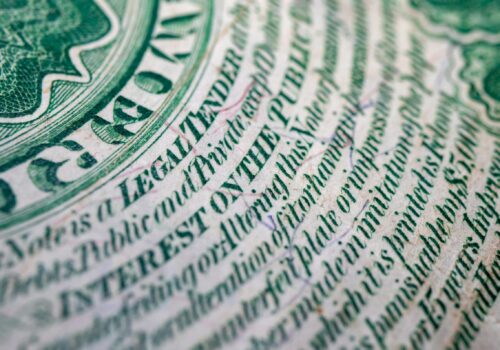What’s the Trump administration’s dollar strategy? It depends on who you ask.
The US dollar has been the backbone of the international financial system for nearly a century. According to the Atlantic Council’s Dollar Dominance Monitor, the dollar’s preeminent position remains secure in the near and medium term. However, five months into US President Donald Trump’s return to the White House, there are concerning signs. The dollar’s value has plummeted to near its lowest level in three years as investors reassess their confidence in the greenback amid a rapidly shifting monetary and geopolitical landscape.
Within the Trump administration, there appear to be competing and sometimes contradictory perspectives over what dollar dominance means for US policy interests. The perspectives mirror broader debates beyond the White House about the role of the US dollar. Three divergent playbooks—around the dollar as a reserve, payment tool, and store of value—are worth exploring, not least because they are increasingly at odds.
The “America first” dollar
For Trump, the dollar’s international role appears to be of a piece with his broader “America first” philosophy. Trump’s statements suggest that he sees the use of the dollar in global payments as a symbol of US nationalism. During his campaign, for example, Trump threatened to impose 100 percent tariffs on nations from the BRICS group of emerging economies and others seeking to build alternative currency blocs aimed at undermining “the mighty US dollar.” In his words: “You leave the dollar, you are not doing business with the United States.”
Trump’s renewed tariff policy risks undermining dollar dominance by disrupting the economic relationships that have sustained the global dollar system. The many countries that run trade surpluses with the United States value holding and using dollars in international trade. This is because the dollar boasts strong network effects and highly liquid markets. It offers ease of trade and the convenience of invoicing and settling in a single dominant currency. This creates a cycle: Dollars flow out when the United States imports more than it exports, and then those dollars come back as foreign investment in US assets. If the United States reduces imports significantly—via tariffs or trade restrictions, for example—fewer dollars flow abroad. There are already signs that this is happening: Foreign investors have sold $63 billion in US equities between March and April 2025, and the US dollar index is down 8 percent this year. This marks a major retrenchment given that foreign investors entered 2025 with a record 18 percent ownership share of US equities.
Although tariffs are paid by US importers, they also hurt foreign exporters by reducing demand for their goods. Importantly, these tariffs signal that the United States is willing to use its dominant position in global trade and finance as a tool of coercion. In response, affected countries may seek to reduce their dependencies on the United States by developing alternative payment systems, trading in local currencies, and diversifying their reserves. These likely consequences may be an incentive for the administration to pursue a more moderate tariff policy than originally announced, as is already happening, at least temporarily.
Trump also sees domestic innovation in private sector financial technology as central to sustaining the dollar’s global role. On January 23, Trump signed an executive order encouraging the development of dollar-backed stablecoins issued by private firms to enshrine dollar dominance. As much as 80 percent of the flow of dollar-backed stablecoins is happening outside of the United States, and countries such as Argentina, Brazil, and Nigeria have seen significant adoption of stablecoins for remittances or as a hedge against local currency instability.
US Treasury Secretary Scott Bessent and Federal Reserve Governor Christopher Waller have emphasized that stablecoins could reinforce the dollar’s primacy by creating new demand for US Treasuries, since almost 99 percent of stablecoins are dollar-denominated. While the widespread adoption of dollar-backed stablecoins could reinforce dollar dominance, it also introduces new vulnerabilities. For example, stablecoins could potentially accelerate de-dollarization, especially if nations become concerned about excessive dollarization of their economies and threats to monetary sovereignty.
According to the Atlantic Council’s central bank digital currency (CBDC) tracker, there has been a global increase in retail CBDC development since the Trump administration took office—potentially signaling that countries are creating domestic digital alternatives specifically designed to limit the proliferation of dollar-backed stablecoins in their economies. Moreover, if inadequately regulated, stablecoins could pose systemic risks—such as triggering bank runs or forcing the liquidation of reserve assets during periods of financial stress, destabilizing Treasury markets. Furthermore, widespread stablecoin adoption without appropriate regulations could lead to shadow payment systems evading traditional oversight, undermining sanctions and monetary policy.
Internal tensions within the Trump administration on digital assets are already emerging. Trump’s inner circle of business leaders appear to favor the broader adoption of digital assets to bolster US competitiveness, while national security officials seem to worry that stablecoins could facilitate money laundering and terrorism financing, as well as undermine Washington’s ability to effectively wield sanctions. The ultimate role of stablecoins in the dollar’s international standing will depend on whether these two groups can reconcile the multiple priorities at stake.
The dollar as an economic burden
But there are other views on the dollar in the White House, as well. Stephen Miran, the chairman of the White House Council of Economic Advisers, has argued that the dollar’s reserve currency status comes at a steep cost to American workers and industry. In November 2024, Miran framed the dollar’s reserve currency status as a structural liability—one that forces the United States to run persistent trade deficits and maintain an overvalued dollar to meet global demand for safe dollar-denominated assets. At the time, Miran proposed unconventional remedies, including purposely devaluing the dollar to create a multipolar currency system to share the reserve status burden.
Miran seems unconcerned about the dollar’s share of global central bank reserves but acknowledges the risks of a weaker dollar—primarily that investors might abandon dollar assets, increasing US borrowing costs. His proposed solution is to “term out” US debt by convincing countries to exchange short-term holdings for one-hundred-year bonds. While this would lock in foreign investment and reduce rollover risk, the extremely distant maturity could undermine trust rather than build it. Reserve holders prioritize liquidity and flexibility, so dramatically extending maturities might backfire, accelerating diversification away from dollar assets as the currency depreciates.
A fractured coexistence
At the heart of these competing views lies a critical tension that policymakers must address: The dollar serves multiple functions globally, and each function demands distinct strategic approaches.
Miran’s critique focuses on the dollar’s role as a reserve currency. Trump’s BRICS tariff threats, by contrast, focus on the dollar’s payments role. And the Federal Reserve and Treasury’s emphasis on stablecoins is best understood as an attempt to bolster the dollar’s store-of-value function. These are different hats that the dollar wears, and they often require divergent policy responses. Managing one of the hats without due attention to the others risks internal contradictions that could erode the very dominance policymakers seek to preserve.
It is unclear which side within the administration will ultimately have more influence, leading to uncertainty about US policy in the interim.
So what’s the dollar strategy, then?
To maintain long-term dollar dominance, the Trump administration should focus on creating a cohesive policy that reconciles the dollar’s multiple roles and avoids conflicting policy actions. Central to this effort should be a commitment to financial stability (avoiding large-scale tariffs, significant currency manipulation, and cryptocurrency spillover). The world is more likely to view the dollar as trustworthy when it sees the United States as a stable and reliable custodian of foreign assets.
Here are three specific ways the White House can pursue a strong, cohesive dollar policy:
Promote responsible innovation and oversight of dollar-backed stablecoins: The administration—particularly national security agencies, the Treasury, and the Federal Reserve—should actively monitor risks posed by the global proliferation of dollar-backed stablecoins. Policymakers should not ignore the accelerated dollarization of emerging markets and potential restrictive responses. Regulation alone is insufficient; clear enforcement mechanisms are needed to ensure compliance and mitigate systemic risk.
Seek stability through strategic trade measures: The administration should prioritize a stable trade policy and eliminate broad, across-the-board tariffs. Instead, it should apply targeted measures to address specific instances of nonmarket practices and currency manipulation. This would help preserve the dollar’s role by maintaining global investor confidence and ensuring continued dollar circulation in trade without disrupting broader relationships or supply chains.
Reinforce institutional credibility and policy coordination: Reaffirming the Federal Reserve’s independence is important for maintaining global confidence in US monetary policy, capital markets, and the dollar’s long-term strength. At the same time, the administration should enhance the coordination of analytic efforts and ensure consistency across agencies in messaging and policy implementation on dollar-related issues. This could be achieved by more effectively leveraging existing interagency structures, such as the National Security Council and the National Economic Council. Or, if necessary, it could be done by creating a new, dedicated coordination mechanism. The key objective is to deliver greater clarity, predictability, and coherence in the government’s approach.
Above all, policymakers should recognize that the greatest threat to the dollar is not external—it is the erosion of trust in the United States’ political and legal institutions. The dollar is not just backed by the size of the US economy; it is backed by faith in the rule of law, the sanctity of contracts, an independent central bank, and the stability of democratic governance. Structural advantages—network effects, deep capital markets, and the dollar’s centrality to global payments—make its dominance resilient. But these foundations are only as stable as the legal, political, and institutional frameworks behind them. If that foundation weakens, then no number of tariffs or volume of stablecoins can preserve the dollar’s central role in the global system.
For now, there is no viable alternative to the dollar. But the Trump administration’s competing and fractured view on the dollar’s various roles may cause enduring harm to its long-term dominance.
Alisha Chhangani is an assistant director at the Atlantic Council’s GeoEconomics Center.
Israel Rosales contributed to the data visualization in this article.
Further reading
Tue, May 20, 2025
Why the US cannot afford to lose dollar dominance
Atlantic Council Strategy Paper Series By Martin Mühleisen, Valbona Zeneli
Since World War II, US geopolitical influence has been compounded by the role of the dollar as the world’s dominant currency. As global economic power becomes more diffuse and strategic competitors “dedollarize,” policymakers must determine how to maintain the dollar’s role at the center of global trade and financial networks.
Thu, May 22, 2025
Gold’s geopolitical comeback: How physical and digital gold can be used to evade US sanctions
New Atlanticist By Kimberly Donovan, Maia Nikoladze
The rise of gold-backed currencies that circumvent the US banking system could create a massive blind spot for US sanctions enforcement efforts.
Thu, Mar 13, 2025
Meeting in Mar-a-Lago: Is a new currency deal plausible?
Econographics By Josh Lipsky, Jessie Yin
Washington is once again chattering about the possibility of a currency deal. But the countries that comprise the US trade deficit today are not the same as the ones in the '80s.
Image: President Donald Trump speaks to the media as he leaves the White House for a trip to Florida on April 3, 2025 (Photo by Andrew Leyden/NurPhoto). Via REUTERS.



